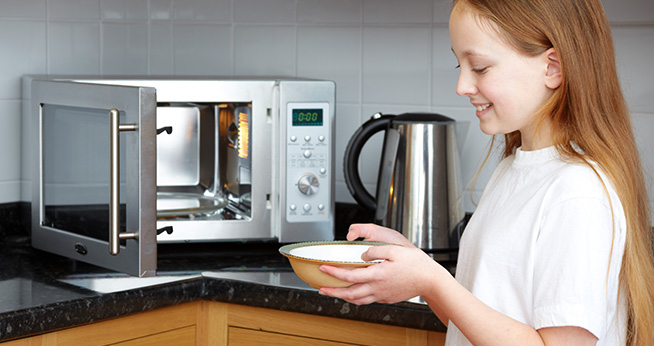Microwave Oven Safety Tips for Your Kids
You might not think twice about letting your kids use the microwave oven…until someone suffers a serious scald or burn injury. The National Fire Protection Association reports an annual average of 7,100 home fires involving microwaves as the source. Microwave-related fires cause hundreds of injuries and millions of dollars in property damage each year. Teach your kids proper microwave oven safety to help prevent serious injuries and house fires.

The Microwave Is Not a Toy
Many child-related microwave accidents do not involve the oven’s heating elements, but rather the weight of the item itself. Children may try to pull microwave ovens down to reach them, tug on microwave cords or swing from microwave doors. This can dislodge the microwave, causing it to fall on the child’s head or crush limbs. Falling microwaves can cause head injuries, brain injuries, bruising, broken bones, contusions and lacerations.
Teach your kids that the microwave is not a toy and that they should ask for help using the microwave until they are tall and old enough to do so on their own. Kids should never pull on the microwave or any of its components. If you want your kids to be able to operate the microwave themselves, put it at a safe height that is within easy reach to avoid them tugging on the oven or its door.
Be Cautious When Removing Foo
Kids often underestimate how hot items can get while in the microwave. They may grab food items with their bare hands, without at least waiting for them to cool off. Eager children may suffer serious burns and scalds from touching hot items from the microwave. Tell your kids to be careful when taking items out of the microwave oven. The food itself or steam from opening a lid could cause burns. Kids may need to use potholders, wait for the food to cool or ask an adult to get the food for them. Test the food’s temperature before giving it to your kids.
Only Certain Things Go in the Microwave
Your kids might not understand what can and what cannot go in the microwave. Certain things are incompatible with a microwave oven’s heating components – posing a risk of melting, sparks, fires and even explosions. Keep a list of items that do not go in the microwave near the oven or taped to the refrigerator to improve household fire safety.
- Aluminum foil
- Anything metal
- Stainless steel travel mugs
- Brown paper bags
- Plastic bags
- Plastic containers or cups
- Styrofoam
Children should also not run empty microwaves. Using the microwave as a timer or just for fun with nothing in it could at the very least damage your microwave, and at the worst cause a fire. Microwave ovens do not operate well when there is nothing inside them to absorb the microwaves. Make sure your children know what and what not to put in the microwave for optimal appliance safety.
Know When it Is Time to Replace
You can help protect your kids from microwave-related accidents and injuries by replacing old, unsafe models. Over time, your microwave could experience malfunctions such as running with an open door or shooting sparks when you turn it on. It is important to watch for signs of something wrong and to replace the microwave oven with a newer, safer version right away.
Sometimes, an accident involving your kids and the microwave is not an accident at all. It could be a preventable incident the microwave manufacturer is responsible for causing. Hire a product liability lawyer to investigate whether the microwave contained a defect that made it unreasonably dangerous for your family to use. If so, you may be able to file a claim for damages from the manufacturer or distributor. Always check for recalls before purchasing a new microwave oven.

